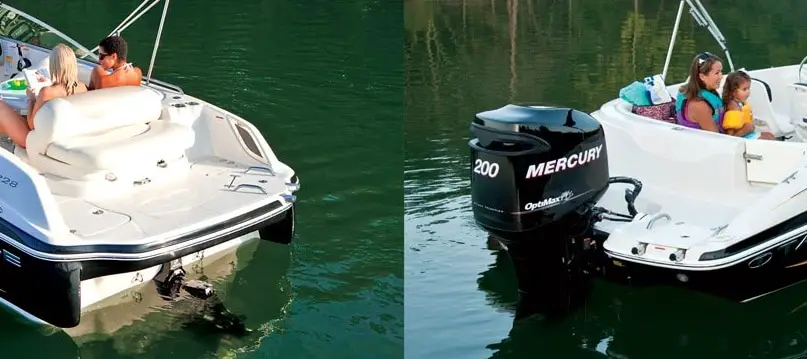If you are relatively new to boating you may be confused about which type of boat engine is best – inboard motor or outboard motor. Two of the most common questions that arise in regards to boat engines are, “what’s the difference between an inboard and outboard motor?” and “which type is the best choice for me?“. By the time you’ve finished reading this article you will be able to answer both these questions.
Contents
- Inboard vs Outboard Motors – the key differences
- The 2 types of inboard motor design
- Outboard motor design
- Inboard vs outboard motor – the advantages & disadvantages of both
- There is a hybrid inboard outboard motor – the sterndrive
- In conclusion: inboard vs outboard motors – differences, advantages & disadvantages
Inboard vs Outboard Motors – the key differences
Although there are various subtle differences between an inboard and outboard motor the main difference lies in where the engine is situated on the boat.
- An inboard motor is typically embedded in a central position in the hull (though not always).
- An outboard motor is a separate unit that is attached, and can be detached, to the transom at the rear of the boat.
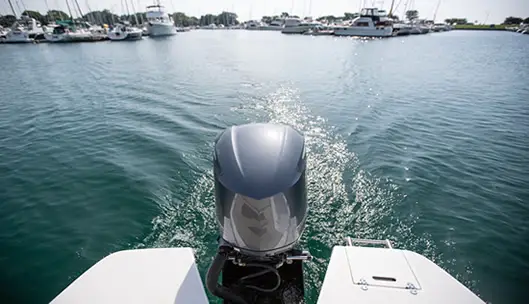
Let’s take a closer look at both these engine types so you can can quickly and easily see which one is the better choice for you and your boat.
Outboard vs inboard – how to find the best motor for you
You may be on the market for a new boat from a dealer, or maybe you have scored a great deal on a used craft.
Well one of the most important considerations when buying a boat is a boat’s engine.
The type/specification of a boat’s marine motor is, to a very large extent, a key determinant in the performance of a boat.
The motor will not only affect the speeds you will be able to attain out on the water but it will also affect fuel consumption, stability and handling.
The choice of motor will often be determined by the main use of your vessel. Specific motor types are better fits for certain activities than others.
The first question you should ask yourself is which motor is better for the intended purpose of my boat?
Is your boat going to be used for water-sports, such as paragliding or waterskiing. Or, is the main purpose of your vessel leisurely cruises or ocean-going outings?
Perhaps you need a boat for hunting or angling in shallow waters. What is the purpose of your boat?
One of the first decisions you will need to make, when it comes to your boat’s engine, is whether you will have an inboard or outboard motor, or perhaps you may need a combination of both (more on this later).
So, before you can decide on the type of engine you need you must understand the difference between outboard and inboard engines.
Let’s take a look a that topic now.
The 2 types of inboard motor design
An inboard motor, often just referred to as an inboard or sometimes called an inboard engine, is a type of marine engine which is housed specifically within the hull of a boat.
This type of marine propulsion unit usually involves a gasoline, electric or diesel engine that drives a propulsion screw via a driveshaft.
Inboard engines bear some similarities with automobile engines in structure and function, and some also share parts with them.
This type of motor is a subclass of the marine engine called a marine automobile engine.
Like an automobile engine inboards rely on combustion to drive pistons which turn a driveshaft that produces the spinning motion that helps to propel the vessel.
The rotating motion of the drive shaft is transmitted to the gearbox which in turn drives the boat’s propeller that is situated underneath the boat.
With inboard engines, water is pumped from outside as part of the engine coolant system to prevent engine overheating and this water is then ejected via the exhaust pipe.
The injection of cooling water into the exhaust pipe, has the added advantage of cooling the exhaust and muffling engine noise.
There are two types of inboard engine:
- D-Drive
- V-Drive
To better understand how inboard motors work we will look at each of these different types of inboard motor.
D-Drive inboard engines
D-Drive inboard motors, short for Direct Drive motors, refers to an engine that is mounted centrally inside the boat.
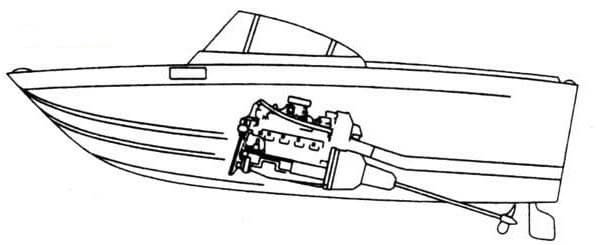
These engines have the propeller and rudder built into the hull which protrude directly underneath the boat.
D-Drive motors are usually fitted to boats that are used specifically for water skiing because they leave very little wake.
V-Drive inboard engines
V-Drive motors, like their D-Drive counterparts are built into the boat with a propeller and rudder protruding from underneath the boat.
However, even though both engines are placed inside the boat unlike the D-Drive motor the V-Drive motor is not placed centrally but is placed close to the transom at the rear of the boat.
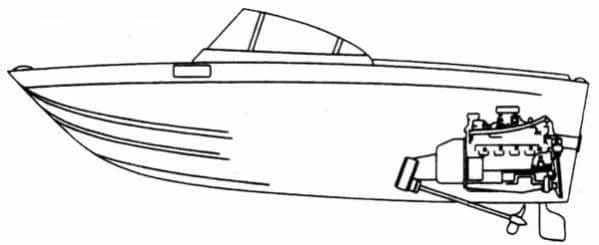
V-Drive Inboard engines are most commonly found on watersport boats making it easy to wakeboard, wakesurf, tube and kneeboard.
Inboard engines come in all sizes with the biggest being huge, though these type of monsters are used mostly in large ocean-going cargo-hauling vessels.
Outboard motor design
An outboard motor, often just referred to as an outboard or sometimes called an outboard engine, is a self-contained propulsion system for boats that is usually attached to the outside of the boat on the transom.
Outboard motors are one of the world’s most common types of marine propulsion system and can be found on watercraft of all types and sizes.
Outboard motors are portable & easier to replace
Outboard motors are comprised of a powerhead which houses the engine and which, more often than not, has a tiller attached, a midsection with exhaust and a lower unit with attached gearbox and propeller.
A skeg in the lower unit also acts as a rudder.
Outboard motors are known for their portability. Small outboards, usually attached by clamps, can easily be moved from boat to boat.
The portability of an outboard motor means that replacing a worn-out engine, or removing a damaged one for repair, is a relatively easy task.
Larger outboards can be tiller steered up to 100 HP. Anything above this will usually have a connection to onboard controls and a steering system controlled by a steering wheel at the helm.
There are 2, 3 and 4-cylinder outboard models that can provide significant power output.
The V8 cylinder block found in Yamaha’s largest outboard engine is capable of propelling a 37 foot vessel comfortably at speed.
Selection of the right outboard is critical for the performance of the vessel with engines being selected, in particular, for power and shaft length.
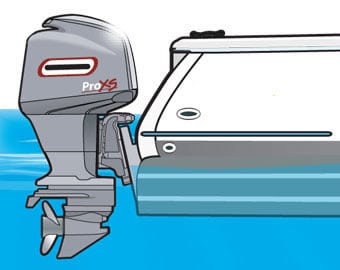
Inboard vs outboard motor – the advantages & disadvantages of both
For the the smaller boat owner (those used for recreational purposes such as a canal boat, hunting, fishing or utility work such as a Jon boat) it is important to consider the key differences between inboard motors and outboard motors.
Understanding the key differences between an inboard motor boat and a boat fitted with an outboard motor will help you to evaluate the suitability of a vessel, or motor, which you are considering purchasing.
This includes its performance, ease of use and maintenance needs.
Here are some key points to consider:
Inboard motor advantages
- Larger engines can be accommodated inboard. Because an inboard engine is embedded into the boat hull, larger engines can be used thus offering more power. A similar sized outboard engine may be unsuitable for the same boat as its size and weight could comprise stability and it may be too heavy to fit to the transom.
- Inboard engines offer better weight distribution. As the inboard engine, is more often than not, located centrally in the vessel these boats will, have better weight distribution, a lower center of gravity, sit lower in the water and have an edge on stability over rear-heavy outboard engines.
- There are two types of inboard engine: D-drive and V-drive. D-drive engines are centrally located with the prop and rudder underneath the boat. V-drive inboards are located towards the transom with prop and rudder in-built in the hull. These two types of engine add further variation in performance and usage.
Inboard motor disadvantages
- Increased risk of prop damage in shallow water. Navigating shallow water or underwater obstructions can cause real damage to the parts of an inboard engine as they are built into the hull and cannot be maneuvered out of the way like an outboard engine.
- Inconvenient access for repairs. Repairs and replacements are less convenient as access to the inboard engine can be difficult or tricky unless the boat is very large.
Outboard motor advantages
- Portability. The ability to attach and detach the entire engine is the outstanding feature of outboard motors. This makes them easy to move, repair and replace.
- Great maneuverability. The ability to trim via a directly controlled rudder is a great feature of an outboard motor. This means that the rudder on an outboard can be lifted to deftly avoid obstacles quickly, especially in shallower water.
Outboard motor disadvantages
- The pilot of a boat with an outboard motor has to sit at the stern to control the boat. Outboard motors are mostly controlled via a tiller and thus the pilot must be seated near the engine.
- The dimensions and thickness of a boat’s transom will limit the size of the outboard that can be attached. With outboard motors the size and bulk of larger engines can be more than a small boat can cope with. Engine size is relative to the transom dimensions and thickness for safe and secure clamping. Though outboards offer exceptional power output for their size, some boats can be underpowered because they can only accommodate a small outboard motor thus leading to significant loss of performance.
There is a hybrid inboard outboard motor – the sterndrive
In addition to outboard and inboard engines there is a third type; the hybrid inboard/outboard which is worth mentioning.
Hybrid inboard/outboard motors, often called I/O engines for short, are also known as sterndrives.
This engine configuration aims to marry the benefits of an inboard motor with the benefits of an outboard motor to create a more powerful engine unit than either one individually.
This motor is fitted inside the boat just behind the transom (like an inboard V-Drive) but has an outer drive unit protruding out behind the boat (like an outboard).

In conclusion: inboard vs outboard motors – differences, advantages & disadvantages
Boaters who want a reliable and readily maintained engine for a smaller or flat-bottomed vessel are probably best served by an outboard motor.
An outboard can be more easily maintained, repaired and replaced than an inboard motor.
When it comes to ocean-going vessels more often than not an inboard motor will be the engine of choice.
However, there are not fast and fixed rules on this. Typically though large vessels will be powered by inboard motors.
Backyard boat builders need to be diligent about the safe powering of their watercraft.
It is important to remember that small flat bottomed vessels, such as Jon boats, are not typically designed to accommodate inboard engines, but a moderate HP outboard will be more than enough to give superior performance on the water.
We actually demonstrated how easy it is to build your own outboard motor here – you’ll be surprised at just how easy it is!
The US Coast Guard has excellent resources on the safe powering of boats including safe outboard horsepower capacity and safe loading. Details can be found here.

